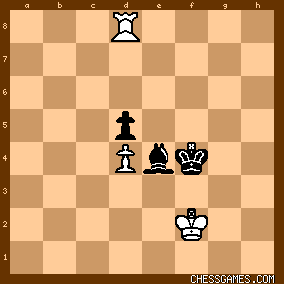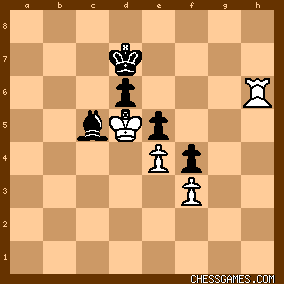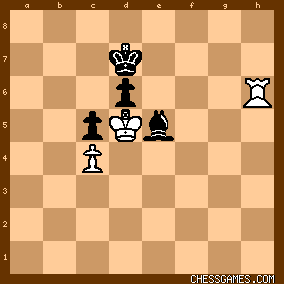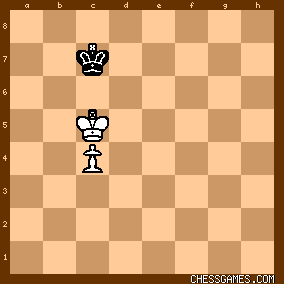|
< Earlier Kibitzing · PAGE 2 OF 2 ·
Later Kibitzing> |
Apr-08-07
 | | keypusher: <zev22407> Sure looks like it. I've looked at this game more than once and that never crossed my mind. Good eye! |
|
| Jun-11-08 | | DrGridlock: Computer analysis by Fritz gives 29 ... Rd1 a value of -3.47, and the move 29 ... e4 a value of -3.09. Both dominant positions for black, but a preference for the Rd1 continuation. |
|
| Jun-11-08 | | RookFile: 20.... c5 was nice. |
|
| May-28-09 | | Travis Bickle: Fischer plays a crushing endgame! |
|
| May-29-09 | | kurtrichards: 55. ... Qg6+ 56. King move Qg8 trapping the White queen and there is no stopping black's pawns for promotion. Simple. |
|
| Nov-08-10 | | tentsewang: A very memorable game. Fischer's really focused!! |
|
| Apr-16-13 | | Zugzwangovich: In his notes to this game in "Profile of a Prodigy" Frank Brady makes the outrageous and wholly unsubstantiable comment that White gets a winning Kingside attack with 8.Qf3. |
|
| Apr-16-13 | | Petrosianic: Does he give any variations? Brady is only an A player, so you have to take him with a big grain of salt. That's pretty gutsy if he assured us that the winner of the game was lost for reasons that aren't at all obvious. 8. Qf3 does look slightly better than what Evans actually played, but White looks only slightly better to me. I don't see anything that looks even close to winning. Black hasn't even castled yet, and I assume he wouldn't if White had a winning attack there. I just looked it up in Fritz to see if I'm missing anything obvious. Fritz says +0.34 after Qf3, which is basically equal. It's database shows a 55% score for White after this move, which again, is very far from indicating a won game. Speaking of non-specific assurances, what would any Fischer win be without Travis Bickle's gushing assurance that the game was great in ways he can't explain? |
|
| Apr-18-13 | | Zugzwangovich: <Petrosianic> No variations, just the unsupported statement, "Here White can obtain a winning Kingside attack with 8.Q-B3." I'm only a C player (so what do I know?) but this note strikes me as preposterous. |
|
| Apr-18-13 | | TheFocus: <but this note strikes me as preposterous> I would have said ridiculous. I skipped over Brady's notes in that book. If I wanted to read a Class player's notes, I would have written my own. |
|
| Apr-19-13 | | Peter Nemenyi: In fairness to Brady, he obviously knew his limitations, and his annotations rarely even attempt concrete analysis. They're mostly platitudes such as "Trying to get his Bishop centralized", too obvious to be wrong. This unsupported implication that Fischer should have had a lost game after eight moves is absurd, but atypical. |
|
| Apr-19-13 | | Petrosianic: <Zugzwangovich>: <No variations, just the unsupported statement, "Here White can obtain a winning Kingside attack with 8.Q-B3." I'm only a C player (so what do I know?) but this note strikes me as preposterous.> Even if were correct, what good is it if it's not obvious, and if the author doesn't show his work? I remember having that problem with some of Reinfeld's works. He'd imply that perfectly playable lines were unplayable just because he wanted beginning players to steer away from them. But then when you played <against> them, a reader would expect them to fall apart, and be surprised when they didn't when played by someone who knew how to play them. What good would it be to know that Qf3 won if you couldn't see it and the author didn't explain it? This reminds me of an old letter to Larry Evans in a 1976-ish magazine. Someone wrote in with a White to play and Win puzzle from one of Lasker's books. One where White had Rook and Pawn and Black had Bishop, two pawns and a mean blockade. The book didn't give the answer, and the reader and his whole club couldn't find it. Evans couldn't find a clear win either. I hope Lasker wasn't kidding. I've always meant to go back and look that one up, and let Fritz have a go at it. I'm thinking off the top of my head that this is from January 1976, but if not there, then about that time. |
|
| Apr-19-13 | | Petrosianic: I'm trying to remember the puzzle now. It was something like White Pd4, Ke5, Rook somewhere or other (maybe h6). Black had a V formation, Pawns on d5, e6, Bishop f5. King maybe around e7-ish. White's pawn is blocked, so the only winning attempt seems to be to sac the Rook for Bishop and Pawn in such a way and time that you can be sure of picking up the d5 pawn later. The problem is that White's pawn is only on d4, so the minute White takes the d5 pawn, Black plays Kd7, takes the opposition and draws. I could see that much, but Lasker said there wsa a win. Maybe there was for him. Or maybe there was a misprint and everything should have been scooched one rank forward, which would make it easier. Either way, he should have given some kind of answer, not just said White wins, work it out for yourself. Capablanca did that in Chess Fundamentals. He had a K+2P vs. K+1P problem. He assured the reader that P-B5 only drew because Black plays P-N3 and draws (the student should work this out for himself, he said). The problem is that P-N3 DOESN'T draw. White still wins by force, and I have no idea what move Capa missed. If he'd given some variations, we could learn from them. |
|
| Apr-19-13 | | Petrosianic: The more I think about this problem (and I wish Evans had said this), the only possible winning method would involve trying to force the Black King so far away from the action that he can't take the Opposition when White sacks the exchange and plays Kxd5. But is it possible to force him that far away, and how do you do it? I don't think I'll bother running the problem through Fritz. It seems like it has too much long range planning for a computer to know what to do. But geez, for Lasker to dump this on beginning readers with no solution and just tell them to work it out for themselves. Who says Imperial Germans had no sense of humor? Or maybe he was just being hard core. What was it Blackadder said? "The Teutonic reputation for brutality is well founded. They have no word for 'fluffy'. Their operas last three or four DAYS." Maybe it's the Sink-or-Swim method of chess instruction. But Brady was just plain wrong. Q-B3 does not win. |
|
| Apr-19-13 | | Nerwal: On the topic of 8. ♕f3 : well, several very strong players have successfully used the plan 8. ♕f3 0-0 9. g4. Of cause claiming a winning attack at move 8 of a normal position doesn't make much sense, but at least the concept isn't stupid. And this Brady isn't the only one to be a little extreme in his judgements. I mean, Sveshnikov has claimed and written things like : "1... e6 and 1... c6 are both mistakes" on a regular basis... <Petrosianic>The only problem of Lasker looking like this I know ( alas I don't have the book) is this one : 
click for larger viewbut here the win isn't too difficult. Once white plays ♖d6 cutting the black king horizontally, black never draws the pawn endgame. |
|
| Apr-19-13 | | Petrosianic: Q-B3 isn't bad, and I'm sure people have won with it, but Brady's claim was that it gives White a winning kingside attack, which it doesn't. This isn't the right problem, as Black only has one pawn instead of two. I think the problem I'm talking about was mentioned in Evans' column of January 1976, and I THINK the reader claimed it came from Lasker's Manual of Chess. |
|
| Apr-19-13 | | Nerwal: <Petrosianic>I have looked a bit further and found this position from the book :

click for larger viewBut with those extra pawns f3/f4 the win becomes simple and Lasker explains it. Maybe the reader just misquoted the position. |
|
| Apr-19-13 | | Petrosianic: Maybe the reader did misquote it, because this isn't the position I remember either. I'm going from memory because I haven't seen this in years, but the position I remember, more or less is: 
click for larger view(I think now that everything was shifted one file to the left of what I said before, because this looks about right now). With 3 pawns on 2, the win is easy. In this one, as far as I can see, the trick is to sac the exchange and win both pawns (ideally with Rxd6, Kxd6, then Kxc5). BUT, you have to do it when Black's King is so far away that he can't respond to Kxc5 with Kc7, and sieze the opposition like this: 
click for larger viewBecause with White to move, this is a draw. So, the trick must be to drive the King away, then come back and give up the Rook for all Black's pieces. But according to Evan's reader, the book gave no solution to this problem. |
|
| Sep-30-13 | | jerseybob: After playing the excellent 12.b4, Evans inexplicably blunders with 13.00?, instead of 13.b5!, recovering the pawn with a slight edge. Fischer, with 13..Ned5! doesn't give him a second chance. |
|
| Oct-01-13 | | Granny O Doul: On my acer chromebook, I apparently can only look at games when I am not signed in, so I have not looked at this one, but.... Brady's analysis should in general be taken with a large glassful of salt. I remember his claiming a win for Larsen in game 6 from Vancouver with a Qg5+ move that would in fact have left Larsen four pawns down for nothing within a move or two. On the other hand, I respect him for doing his own work. |
|
Oct-04-13
 | | perfidious: <Zugzwangovich: No variations, just the unsupported statement, "Here White can obtain a winning Kingside attack with 8.Q-B3."....this note strikes me as preposterous.> Believe Brady was A level, but he should have known better, really. It is curious that 8.Qf3 never showed up in any of the games I played with this subvariation-with either colour. |
|
Apr-10-21
 | | kingscrusher: <perfidious:> Funny enough, it seems in my chessbase that 8.Qf3 is now one of the main moves to play. Livebook has 8.b3 with 212 games but 8.Qf3 has 84 games. It does have a lot of logic and I have seen a variation ending in a slight edge for White with the latest Stockfish analysing it. E.g. Qf3 0-0
g4 c6
h4 Bxc4
Bxc4 dxc4
h5 e5
h6
and it does seem quite dangerous for black.
Essentially Caveman style k-side counterplay - which does seem a good antidote if Fischer is aiming to win a queenside pawn. |
|
| Apr-10-21 | | Granny O Doul: Evans' famous stalemate swindle vs. Reshevsky was just two years earlier, so I guess the memory of it was just too fresh. |
|
Apr-10-21
 | | MissScarlett: <In his notes to this game in "Profile of a Prodigy" Frank Brady makes the outrageous and wholly unsubstantiable comment that White gets a winning Kingside attack with 8.Qf3.> Let's be generous and assume there was a problem with editing; he probably meant that Qf3 begins a Kingside attack. |
|
| Dec-18-23 | | newzild: <zev22407> Nice! |
|
 |
|
< Earlier Kibitzing · PAGE 2 OF 2 ·
Later Kibitzing> |





































